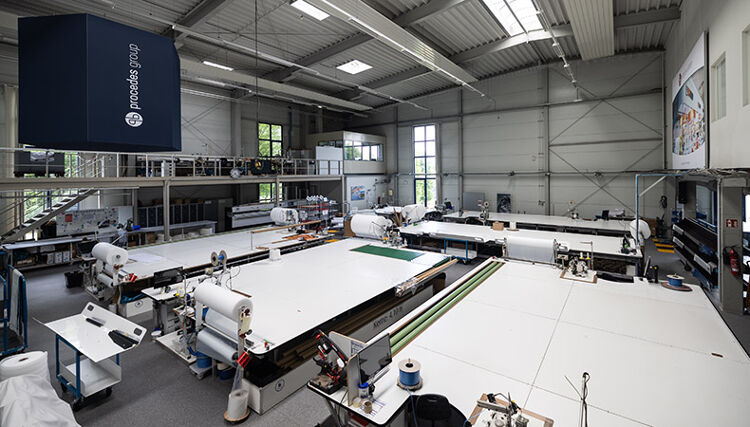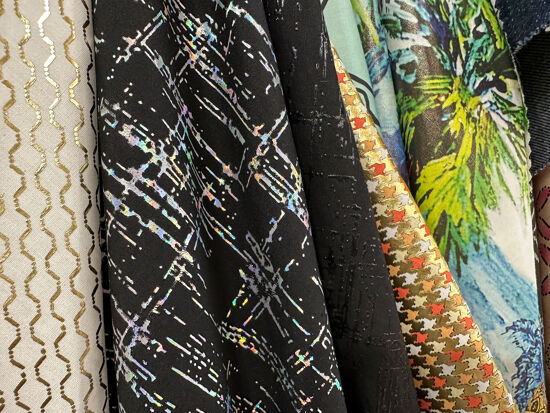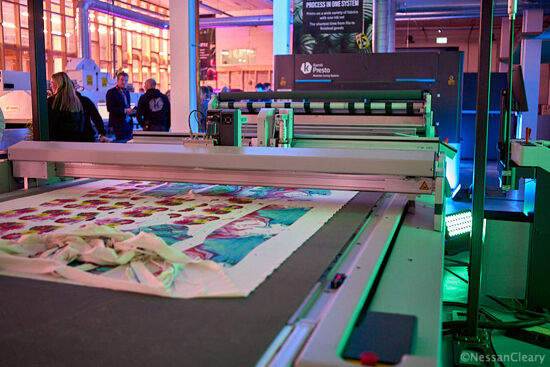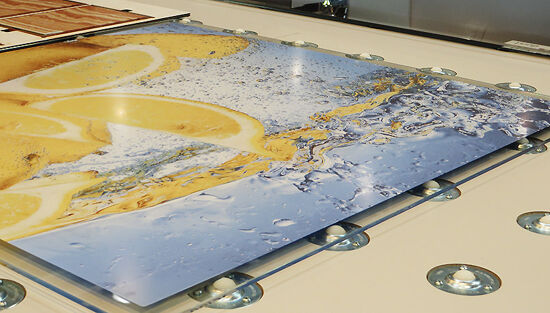The importance of automation and digitalisation in textile printing

The Procedes Group is one of the biggest organisations in textile printing. Automation and digitalisation play a key role in this. Sonja Angerer speaks to Managing Director Alexander Beilken and discusses how the company based in Lemwerder managed to achieve this.
“Procedes Chenel Beilken Digital Printing is a real pioneer of digital printing.” says Alexander Beilken, “As the company was founded in 1990, its roots can be traced back to 1919, to the Beilken sailmaking factory.” Therefore, it’s not a surprise that Procedes specialised in digital textile printing. The group is now spread across six locations, one of which is in the USA since 2020: Procedes LLC in Chicago.
“If you really want to do business in the United States, you need to have your own production there,” Beilken is convinced. The business economist took over management from his father Berend Beilken in 2016. He was just 26 years old. Since the mid-1990s, Procedes has specialised in textile printing in the project business.
“To this day we are primarily focused on the event and trade fair construction industry. In the past, these have often involved very large trade fair projects from well-known companies. This meant that at times we were working for only a few customers for weeks or even months. The further processing of textile prints has always been a struggle. A lot of manual work by skilled personnel was required here. That’s why around 40 of our 240 employees are still employed in the sewing department today.”
Beilken saw that such project business entails significant dependency risks. In addition, the options for streamlining processes are significantly limited for individual items. “I therefore began to consistently set the company’s course towards automation and digitalisation. Today, we deliver 30,000 - 40,000 textile printing orders every year. Our main market is Central Europe, but the USA is also developing well. Without consistent automation and digitalisation, this wouldn’t be possible with our workforce.”
 CAPTION: Alexander Beilken took over the management of the Procedes Group in 2016 at the age of just 26. Image Credit: Procedes.
CAPTION: Alexander Beilken took over the management of the Procedes Group in 2016 at the age of just 26. Image Credit: Procedes.
Automation: get your employees involved
“At the age of 22, I had already founded a start-up, Procedes Square, which is now Procedes ID interior design,” he comments. “With a start-up like this, you start from scratch, i.e. without legacy issues, but also without a large capital base and employee base. At Procedes ID, we have relied on consistent digitalisation and the greatest possible automation right from the start.
I also learned that it's not just about technical processes. You must get every employee in the company involved. Digitalisation and automation, whether in textile printing or elsewhere, should offer benefits to everyone. You must manage expectations, but most importantly you must create a real improvement in working conditions. This only works if you invest permanently in training and further education. Such consistent change management also costs a lot of money. In recent years, we at Procedes have invested a 6 figure sum in further training measures for management and staff.”
Together with a modern, appreciative management culture, the automation and digitalisation measures at Procedes have meant that the company currently has no problems with a shortage of skilled workers. “We have many employees in customer service and administration who work completely or partially remotely,” says Beilken.
 CAPTION: Every step of the workflow, for example digital cutting, is mapped in the software. Image Credit: Procedes.
CAPTION: Every step of the workflow, for example digital cutting, is mapped in the software. Image Credit: Procedes.
Use standard software for textile printing
The starting points for digitalisation at Procedes were isolated solutions with standard software, for example from Durst, Caldera or Enfocus. This initially resulted in “Traffic Light”, a software that was used in production and by customer service employees. Ten years ago, it only documented the processing status of a project. Today, the entire production process is digitalised via the self-developed project manager.
Procedes now also has its own department that manages the maintenance and further development of the in-house automation solution. “We use the APIs of modern standard software and combine them with Javascript and other solutions to create a complex workflow with its own front end. “Today, this ranges from preparing offers and checking customer data to production, further processing and logistics,” explains Beilken. To date, the company has invested a 7-figure sum in software and programming services.
To prevent the software from becoming too confusing, the display is role-based. This means that, for example, seamstresses can only see their next orders, but logistics employees know exactly which packages must leave the house today. There is production control, but also classic MIS/ERP views. Even post-calculation or product development can be rationalised using the information collected in this way. “We plan to increasingly use artificial intelligence for data analysis in the future,” he says.
“We consistently work in production up to three shifts every day,” says Alexander Beilken. “An order is printed in the morning if possible and packaged in the late afternoon. This means we need little storage space and can always tell customers immediately where their order is. After all, at Procedes we don’t just sell prints, but above all the security that they will be at the right place at the right time for the customer.”
 CAPTION: Sublimation and UV prints are produced in Lemwerder, e.g. with the Durst P5 510. Image Credit: Procedes.
CAPTION: Sublimation and UV prints are produced in Lemwerder, e.g. with the Durst P5 510. Image Credit: Procedes.
Automating production
However, such a consistently digitised workflow requires more than just software. Textile print orders for Europe are produced in Lemwerder and Cologne. Other locations in the group have focused on plate printing or advertising technology, for example. Only sublimation or UV direct printing are used for textiles. Production takes place on robust industrial machines with a print width of up to five meters.
"We concentrate on our standard materials, which we can buy in large quantities. This means we only need a little time for roll changes, and the settings rarely need to be changed during further processing. Our printed products are consistently optimised for our own piping and frame profiles. Many of our customers have used these for their exhibition stands for years. This also helps to reduce the ecological footprint in exhibition construction."
Digitisation in Germany? It's happening!
It is astonishing that the combination of automation and digitisation is working so well at Procedes. Germany and its employees are considered to be rather skeptical of digital processes. "It seems to me that this is often due to the fact that the team's expectations are not met, and software is being adapted too much to the company's own, non-standardised processes," says Alexander Beilken.
"If automation and digitisation lead to work processes being condensed, employees being laid off, or a workflow simply no longer working, then this creates resistance. Consistent change management and a positive company culture in which every employee is valued contribute to the success of automation and digitisation in textile printing."
To discover the latest content that covers a wide range of sectors including textile printing, software and automation sign up for FESPA’s free monthly newsletter FESPA World available in English, Spanish and German.
Topics
Interested in joining our community?
Enquire today about joining your local FESPA Association or FESPA Direct
Recent news

How Epson's cutting-edge technology is redefining textile printing
Debbie McKeegan speaks to Francesco Nozza, Business Development Manager at Epson Italia about his insights on the future trends of industrial direct-to-textile printing using digital technologies.

Are digital screens for interior displays a challenge for printers?
Nessan Cleary discusses how the increased popularity of using digital screens for interior displays may pose a challenge for printers. Nessan states there are numerous sustainable options for prints designed for interior spaces.

How the success of digital textile printing is reliant on advances in finishing
Nessan Cleary shares how the success of digital textile printing is dependent on the advances in finishing for textile production. The level of automation is a contributing factor to the efficiency of localised production and a more sustainable approach.

What are the pros and cons of inkjet printing?
As a growth segment in digital printing, Industrial Inkjet (IIJ) is still a popular technology. Sonja Angerer discusses the technologies, the advantages and disadvantages of industrial inkjet and the market opportunities for print shops in IIJ.